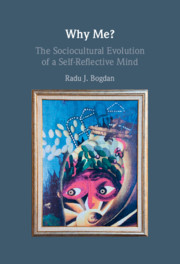Book contents
- Why Me?
- Why Me?
- Copyright page
- Dedication
- Epigraph
- Contents
- Acknowledgments
- Introduction
- 1 Framing the Issue
- Part I The Architecture
- Part II The Evolution
- 4 An Evolutionary Paradigm
- 5 Reasons for Self-Reflection
- 6 Scaffolding Self-Reflection
- 7 A Public Sense of Me
- 8 Questions and Answers
- Glossary
- References
- Index
6 - Scaffolding Self-Reflection
from Part II - The Evolution
Published online by Cambridge University Press: 28 May 2021
- Why Me?
- Why Me?
- Copyright page
- Dedication
- Epigraph
- Contents
- Acknowledgments
- Introduction
- 1 Framing the Issue
- Part I The Architecture
- Part II The Evolution
- 4 An Evolutionary Paradigm
- 5 Reasons for Self-Reflection
- 6 Scaffolding Self-Reflection
- 7 A Public Sense of Me
- 8 Questions and Answers
- Glossary
- References
- Index
Summary
The adaptive response to the external pressures and mental challenges encountered by older children takes the form of self-strategizing, as the operational core of a variety of mental activities, such as self-centered planning, plotting one’s actions in a social setting, deliberation concerning self and others, and so on. Self-strategizing consists in factoring and integrating representations of the goals, actions and mental states of others into those of one’s own goals, mental states and attitudes. To be adaptive and effective, self-strategizing must regulate its reflective initiatives relative to the norms, rules and practices of the surrounding culture as well as the attitudes and reactions of others toward self. This regulatory dimension of self-strategizing is manifested as conscience. The evolution of conscience-regulated self-strategizing assembled and scaffolded the mental architecture of self-reflection for its central role of regulatory supervisor. Section 6.1 introduces the working notion of scaffolding. Section 6.2 is about self-strategizing, and Section 6.3 about conscience.
Information
- Type
- Chapter
- Information
- Why Me?The Sociocultural Evolution of a Self-Reflective Mind, pp. 113 - 135Publisher: Cambridge University PressPrint publication year: 2021
